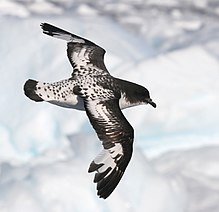Procellariidae
| Procellariidae | |
|---|---|
 |
|
| Cape petrel (Daption capense) | |
| Scientific classification | |
| Kingdom: | Animalia |
| Phylum: | Chordata |
| Class: | Aves |
| Order: | Procellariiformes |
| Family: |
Procellariidae Leach, 1820 |
| Genera | |
|
Macronectes |
|
| Diversity | |
| 16 genera and about 70 species | |
Macronectes
Fulmarus
Thalassoica
Daption
Pagodroma
Halobaena
Pachyptila
Procellaria
Bulweria
Calonectris
Puffinus
Pelecanoides
Ardenna
Pseudobulweria
Lugensa
Pterodroma
The family Procellariidae is a group of seabirds that comprises the fulmarine petrels, the gadfly petrels, the prions, and the shearwaters. This family is part of the bird order Procellariiformes (or tubenoses), which also includes the albatrosses, the storm petrels, and the diving petrels.
The procellariids are the most numerous family of tubenoses, and the most diverse. They range in size from the giant petrels, which are almost as large as the albatrosses, to the prions, which are as small as the larger storm petrels. They feed on fish, squid and crustacea, with many also taking fisheries discards and carrion. All species are accomplished long-distance foragers, and many undertake long trans-equatorial migrations. They are colonial breeders, exhibiting long-term mate fidelity and site philopatry. In all species, each pair lays a single egg per breeding season. Their incubation times and chick-rearing periods are exceptionally long compared to other birds.
...
Wikipedia
